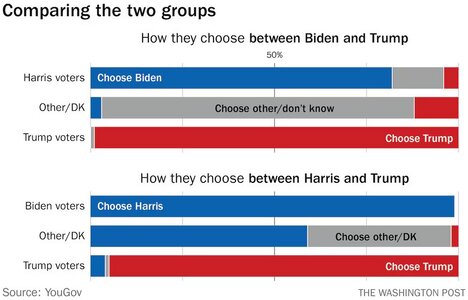I’ll take that!
Navigation
Install the app
How to install the app on iOS
Follow along with the video below to see how to install our site as a web app on your home screen.
Note: This feature may not be available in some browsers.
More options
You are using an out of date browser. It may not display this or other websites correctly.
You should upgrade or use an alternative browser.
You should upgrade or use an alternative browser.
2024 Pre-Election Political Polls | POLL - Trump would have had 7 point lead over Biden
- Thread starter nycfan
- Start date
- Replies: 5K
- Views: 191K
- Politics
- Messages
- 34,522
5 pmWhat time does exit poll info trickle in?
- Messages
- 3,711
North or South?Final "drive through rural and suburban Orange County on my way to school" sign results:
Trump 11
Harris 40
Milk and Cookies
Esteemed Member
- Messages
- 520
Reminder, this vote occurred before DJT directed a violent mob to attack the Capitol to prevent a transition of power
- Messages
- 34,522
NEW EXIT POLL THREAD:
Thought we might benefit from a thread dedicated to the exit polls and turnout data as that becomes available today.
NBC Exit Polls —> National Exit Polls: Election 2024 Results

 www.telegraph.co.uk
www.telegraph.co.uk
“… The embargo period for exit polls will end at 5pm ET on polling day, after which news organisations are allowed to begin reporting results from individual states.
However, at this point they are not permitted to project a winner while voting is still taking place.
Exit polls will...
NBC Exit Polls —> National Exit Polls: Election 2024 Results

Presidential election 2024 recap: Donald Trump secures landslide victory
Donald Trump has won in Michigan, completing his rout of the “blue wall” in a landslide election victory that lays the ground for a radical second term in office.
“… The embargo period for exit polls will end at 5pm ET on polling day, after which news organisations are allowed to begin reporting results from individual states.
However, at this point they are not permitted to project a winner while voting is still taking place.
Exit polls will...
- nycfan
- Replies: 573
- Forum: Politics & Other Topics
aGDevil2k
Inconceivable Member
- Messages
- 4,075
South central. I am not giving you my address.North or South?
Bigs23
Iconic Member
- Messages
- 2,456
Pre Dobbs as well.Reminder, this vote occurred before DJT directed a violent mob to attack the Capitol to prevent a transition of power
- Messages
- 3,711
Oh I don't want itSouth central. I am not giving you my address.
South is Carrboro , North is Cedar Grove is why I asked Night and Day
I think that's definitely going to be the face of it. I hope the whole dictating other people's moral beliefs and personal freedoms are a big part of the structure.IMO when this is all over, it was Dobbs. It was always Dobbs.
HeelYeah2012
Honored Member
- Messages
- 847
Yep. If Democrats win, this will be the story. If Republicans win, it’ll be immigration and inflation.IMO when this is all over, it was Dobbs. It was always Dobbs.
aGDevil2k
Inconceivable Member
- Messages
- 4,075
Damn see I thought we were going to be friends. South of Hillsborough, but not C/CH.Oh I don't want it
South is Carrboro , North is Cedar Grove is why I asked Night and Day
Though around Cedar Grove it is massively less Trumpy than it was in 2020.
- Messages
- 338
I was talking to a guy I go to church with and he’s a liberal (not as progressive as me) but he believes Trump will win. We both are financially pretty well off and he said that’s disconnected us from the normal persons struggles on inflation. He’s convinced folks are not that complex. Prices are higher now and despite the fact that Trump caused a lot of that, we were coming off a pandemic and we managed the nearly impossible (soft landing), people won’t get it. They see prices are higher and our income has shielded us from that. He works as a supervisor at a manufacturing plant in Apex and is closer to those impacted from inflation.
Who knows and I guess we will see today.
Yeah I have heard some of this sentiment but the bottom line is voters this low on information and in a demographic sweating grocery prices are usually already Trump voters. The question is whether their misinterpretation of the cause of grocery prices/inflation is going to spur apathetic voters to go vote Trump, or turn a vote from Harris to Trump. I could be wrong but I just don't see this being anything like Dobbs or January 6 which are really, really motivating people.
HintonJamesHeel
Esteemed Member
- Messages
- 727
I would agree on Dobbs. I think 1/6 is a nothing burger and won’t impact the election today at all. It should be Americans have crazily grown numb to it all.Yeah I have heard some of this sentiment but the bottom line is voters this low on information and in a demographic sweating grocery prices are usually already Trump voters. The question is whether their misinterpretation of the cause of grocery prices/inflation is going to spur apathetic voters to go vote Trump, or turn a vote from Harris to Trump. I could be wrong but I just don't see this being anything like Dobbs or January 6 which are really, really motivating people.
- Messages
- 34,522
If Trump were running against Biden right now, he’d be up 7 points
New YouGov polling offered Americans an alternative history: What if President Joe Biden hadn’t dropped out?"... Before we dig into the data any further, we will acknowledge that, as with all of these sorts of questions, the results are necessarily tainted by reality. Biden isn’t the candidate and hasn’t been the beneficiary of months of ads promoting his candidacy. His party isn’t forced to vote for him to prevent Trump from returning to the White House, giving Democrats space for apathy that might not have otherwise existed.
... The YouGov survey consisted of two questions, one evaluating support in a Trump-Harris contest and the second in a Trump-Biden matchup. Overall, Harris did eight points better than Biden, and Trump did two points worse against the vice president than the president. The margin goes from a seven-point lead for Trump against Biden to a three-point deficit. ..."

HintonJamesHeel
Esteemed Member
- Messages
- 727
The wild thing is Trump caused as much of the problem on both of these as did the Democrats.Yep. If Democrats win, this will be the story. If Republicans win, it’ll be immigration and inflation.
He spent like a drunken sailor (inflation) and told Republicans to fight against border bills.
- Messages
- 34,522
Nate Silver: “At exactly midnight on Tuesday, we ran our simulation model for the final time in this election cycle. Out of 80,000 simulations, Kamala Harris won in 40,012 (50.015%) cases. She did not win in 39,988 simulations (49.985%).”
FiveThirtyEight gives Harris a 50% chance to win.
Decision Desk HQ gives Trump a 53% chance to win.
The Economist gives Harris a 50% chance to win.
FiveThirtyEight gives Harris a 50% chance to win.
Decision Desk HQ gives Trump a 53% chance to win.
The Economist gives Harris a 50% chance to win.
HintonJamesHeel
Esteemed Member
- Messages
- 727
The model is just seeing national polls at 50-50. It doesn’t say anything.Nate Silver: “At exactly midnight on Tuesday, we ran our simulation model for the final time in this election cycle. Out of 80,000 simulations, Kamala Harris won in 40,012 (50.015%) cases. She did not win in 39,988 simulations (49.985%).”
FiveThirtyEight gives Harris a 50% chance to win.
Decision Desk HQ gives Trump a 53% chance to win.
The Economist gives Harris a 50% chance to win.
superrific
Master of the ZZLverse
- Messages
- 11,171
Wasserman is a good guy. Not a blowhard.What fucking blowhards like Wasserman dont care about with posts like that, while factually correct, they make the situation more dangerous if polls were slanted towards Harris, then the simpletons on the right will riot, and he might have just gotten someone hurt with that post.
Share:
